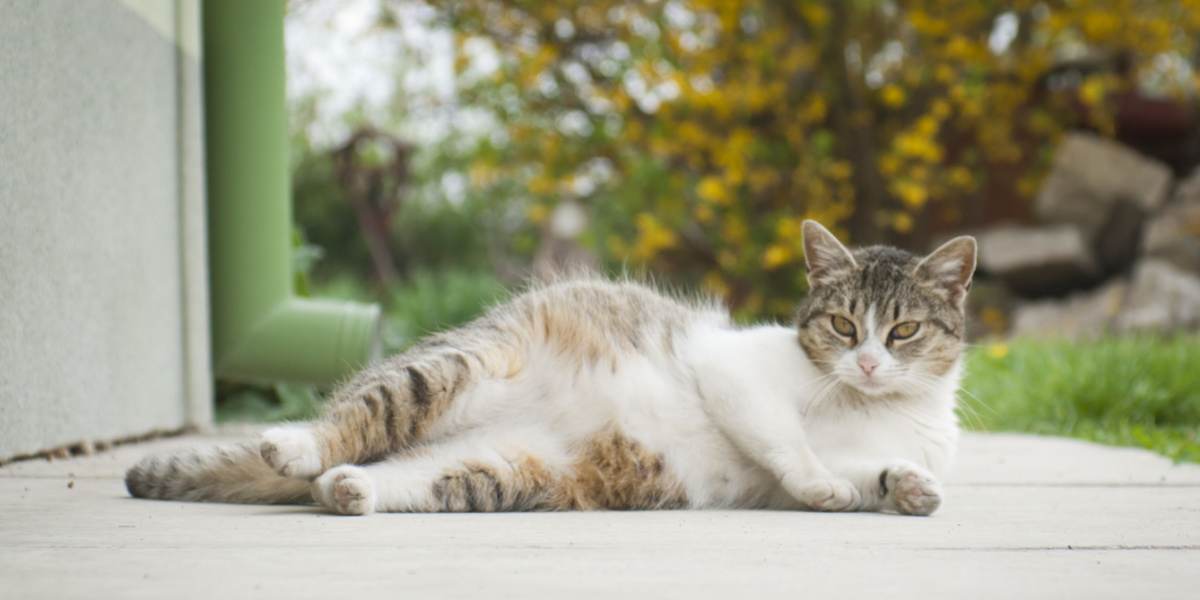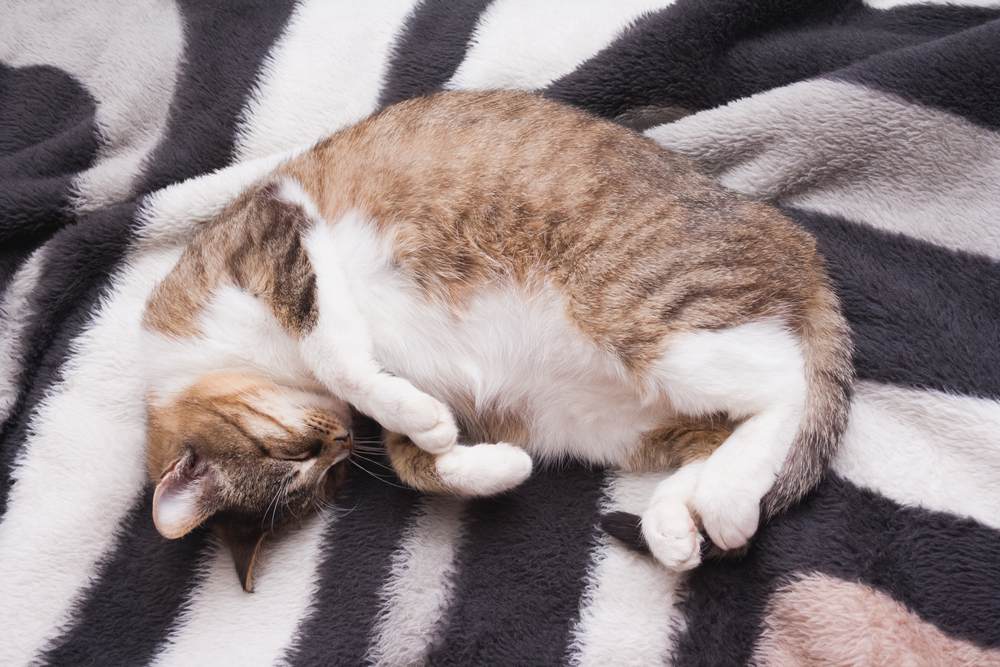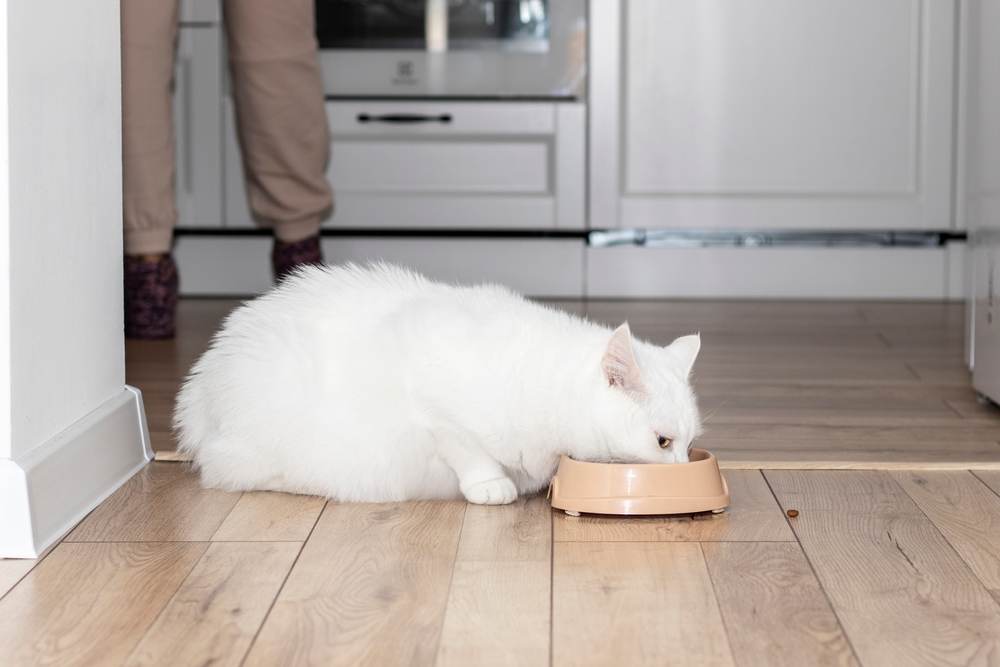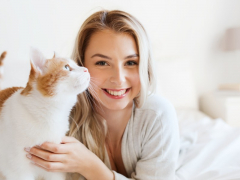
Miscarriage in cats refers to the loss of one or more fetal kittens during pregnancy. Miscarriage might occur for several reasons, and can happen at different times during pregnancy. In this article, learn about some of the underlying causes of miscarriage in cats, signs to look for, how miscarriage might be addressed, and tips for prevention.
Quick Overview: Miscarriage in Cats
 Other Names: Abortion, spontaneous abortion.
Other Names: Abortion, spontaneous abortion.
 Common Symptoms: In early pregnancy there might be no symptoms. In late pregnancy, signs like blood or other discharge from the vulva, lethargy, fever, and poor appetite might be seen.
Common Symptoms: In early pregnancy there might be no symptoms. In late pregnancy, signs like blood or other discharge from the vulva, lethargy, fever, and poor appetite might be seen.
 Requires Ongoing Medication: No.
Requires Ongoing Medication: No.
 Vaccine Available: The FVRCP and FeLV vaccine do protect against viruses that can cause miscarriage.
Vaccine Available: The FVRCP and FeLV vaccine do protect against viruses that can cause miscarriage.
 Treatment Options: This depends on the underlying cause. Treatment options are often supportive depending on the symptoms the cat shows and their severity.
Treatment Options: This depends on the underlying cause. Treatment options are often supportive depending on the symptoms the cat shows and their severity.
 Home Treatment: Ensure proper nutrition for a pregnant cat with food formulated for kittens that is high in calories and protein. Keep your cats well vaccinated. Know when your cat’s pregnancy started so you know what to expect. Be careful with drugs and medications. Many have not been evaluated in pregnant cats. Ensure a clean, safe, and low stress environment for your cat. Consult with your veterinarian for regular health checkups during pregnancy.
Home Treatment: Ensure proper nutrition for a pregnant cat with food formulated for kittens that is high in calories and protein. Keep your cats well vaccinated. Know when your cat’s pregnancy started so you know what to expect. Be careful with drugs and medications. Many have not been evaluated in pregnant cats. Ensure a clean, safe, and low stress environment for your cat. Consult with your veterinarian for regular health checkups during pregnancy.
Can Cats Have Miscarriages?
Miscarriage is also called spontaneous abortion. These terms refer to when a pregnant queen loses one or more of her fetal kittens unexpectedly. The kittens might die for several different reasons. This might occur early in pregnancy or later on.
Loss of one kitten with all other kittens making it successfully to full term is common in cats. This can especially occur with large litters.
Miscarriage generally does not refer to the loss of kittens during the process of a queen giving birth.
Here are some simple facts to know about cat pregnancy:
- Cats are spontaneous ovulators. This means that a female cat can go into heat simply by being in the presence of a male tomcat.
- Mating can occur at almost any time of the year, but most often between February and August.
- Cat pregnancy lasts for 60 to 65 days, or about two months.
- Cats give birth to about 4 to 6 kittens on average. This number can be smaller or larger.
- Pregnancy in a cat can be confirmed with an ultrasound as early as about 20 to 30 days.
- Fetal kitten skeletons can be visible with an x-ray around days 43 to 45.
Causes of Miscarriage in Cats
Miscarriage or spontaneous abortion can occur for several reasons, including infection, hormonal changes, poor nutrition, genetic abnormalities in the kittens, trauma, severe stress, drugs, medications, and toxins.
Infection
Viral infections are the most common cause of miscarriage in queens. The most common viruses implicated in miscarriage in cats are:
- Feline calicivirus
- Feline herpesvirus
- Feline panleukopenia virus
- Feline leukemia virus (FeLV)
- Feline immunodeficiency virus (FIV)
- Feline enteric coronavirus, which causes feline infectious peritonitis (FIP)
Toxoplasmosis, caused by the protozoal organism Toxoplasma gondii, can also cause abortion.
Bacterial infection can also lead to miscarriage. An infection might involve the reproductive tract, but if a cat gets very sick from a bacterial infection somewhere else in the body, the stress and immune response might lead to abortion as well.
Hormonal Changes
Progesterone is the main hormone responsible for maintaining a pregnancy. Poor levels of progesterone might lead to spontaneous abortion. One proposed cause is luteal insufficiency, where the corpus luteum on the ovary is releasing suboptimal levels of progesterone. While commonly appreciated in humans, it has not been studied well in cats.
Poor Nutrition
Pregnant queens might require up to two times their regular nutritional needs, especially close to the end of pregnancy. Pregnancy also requires higher levels of calories and proportions of protein. Although it is possible to overfeed a pregnant queen, nutritional deficiencies usually result from poor quality or low-calorie diets.
Genetic Abnormalities
Most congenital abnormalities (those occurring during pregnancy) in fetuses have no identifiable cause. DNA abnormalities within chromosomes are suspected in some cases. Some of these abnormalities might be inherited genetically from the parents. Environmental effects are also known to cause congenital changes.
Trauma
Any kind of significant physical trauma, such as a fall or other injury, or severe stress can cause elevations in stress hormones that can lead to miscarriage.
Drugs, Medications, or Toxins
A teratogen refers to any substance that can cause abnormal changes to an embryo or fetus. There are some medications that can have these effects and many more chemicals and other substances that can as well.
Some medications that might be used with good intention to treat a pregnant queen for an illness or disease condition might have a negative effect on pregnancy. Many medications have not been fully evaluated in pregnant or nursing cats, so these must be used very carefully.
What Does a Cat Miscarriage Look Like?

If it happens early in pregnancy, you might not know your cat miscarried one or more kittens.
Symptoms of miscarriage in cats can depend on when this occurs during pregnancy. This can be divided into early pregnancy (prior to 30 days) and late pregnancy (31 days to full term).
Symptoms During Early Pregnancy
Prior to 30 days, visible signs of miscarriage are very uncommon. This is because the fetus will be resorbed by the queen’s body.
If breeding was planned, the most common sign of early miscarriage might actually just be that expected signs of pregnancy closer to term have not occurred. Females that are actively bred will usually have a prolonged period before they can go into heat again.
Symptoms During Late Pregnancy
After 30 days but before full term around 60 to 65 days, miscarriage is usually accompanied by the passing of uterine contents. Signs that might be seen include:
- Blood-tinged discharge from the vulva
- Brown, black, or green discharge
- Signs of a fever (lethargy, poor appetite)
- Abdominal pain
- The delivery of stillborn kittens
The amount of discharge and its appearance can vary depending on how late in pregnancy abortion occurs and the underlying cause. Keep in mind that a small amount of discharge might be removed by the queen through grooming, so close monitoring is very important.
Complications of Miscarriage in Cats

If you suspect your cat has miscarried, take her to a veterinarian to be checked out.
The most apparent complication of miscarriage or spontaneous abortion will be the complete loss of one or more kittens. Potentially, the entire litter might be lost depending on the cause and how late during pregnancy it occurs.
The queen herself might not be greatly affected by the miscarriage itself, especially very early on. The loss of one or two kittens in early pregnancy can be common especially with large litters.
Exceptions to this can depend on the cause. If the queen is suffering from injury, infection, or poor nutrition, her own health can certainly be at risk and require veterinary care.
Diagnosis of Miscarriage in Cats
Although a majority of queens can carry a pregnancy successfully and give birth to kittens on their own, it is important to involve your veterinarian if you suspect anything might be amiss.
Your veterinarian will need to know about what time your female cat might have been with a tomcat so an estimate can be made for the stage of pregnancy. This is especially important in early pregnancy before pregnancy can be straightforward to confirm with ultrasound at about 20 days.
A vet skilled in ultrasound might need to wait until about 20 days to determine if any viable pregnancy is present. If a known breeding occurred but no pregnancy can be found with ultrasound at that time, miscarriage might be suspected.
Later in pregnancy, your vet might be concerned about miscarriage with the presence of discharge from the vulva, lethargy, fever, or the expulsion of uterine contents, including stillborn kittens.
Because cats can lose individual kittens and still carry others to term, your vet might still use ultrasound to fully evaluate the viability of any remaining kittens.
Your vet will also need to help you determine the cause of miscarriage. Your vet might wish to test for viral diseases, toxoplasmosis, hormone levels, or a source of bacterial infection.
Treatments for Miscarriage in Cats
Treatment for miscarriage in cats will depend on the underlying cause. Often, treatment is aimed at keeping the queen healthy. By keeping the queen healthy, any remaining kittens might also still make it to full term.
- Nutrition: If poor nutrition is to blame, this can be quickly improved. Food formulated for kittens is ideal for pregnant queens to provide high energy and protein.
- Antibiotics: Many antibiotics are safe to use in pregnant queens if a bacterial infection is present.
- Toxoplasmosis can be treated with the antibiotic clindamycin, which also has an effect against some protozoal organisms. Clindamycin has not been fully evaluated in pregnant animals, though it is known to have no teratogenic effects. Its use might depend on the benefits of therapy for the queen outweighing risk.
- Hormone supplementation: Progesterone supplementation can be considered if low levels were determined to be a cause of miscarriage. Progesterone supplementation must be monitored very carefully.
- Other supportive care: The effects of viral infections can only be addressed symptomatically. Fever, dehydration, poor appetite, and other signs can all be addressed to help the queen through a period of illness.
Pregnant Cat Care Tips
- Ensure proper nutrition for a pregnant cat with food formulated for kittens that is high in calories and protein.
- Keep your cats vaccines updated.
- Know when your cat’s pregnancy started so you know what to expect.
- Be careful using drugs and medications. Many have not been evaluated in pregnant cats.
- Ensure a clean, safe, and low stress environment for your cat.
- Consult with your veterinarian for regular health checkups during pregnancy.
- A board-certified theriogenologist is a veterinarian who specializes in reproductive health. If there is one in your area, their assistance can ensure a healthy pregnancy. They specialize in treating reproductive disorders.
Prevention of Miscarriage in Cats

Feed pregnant cats adequate amounts of a nutritious, calorie-dense cat food.
Some causes of miscarriage can’t be easily anticipated or prevented. Congenital abnormalities and traumatic events cannot be accurately predicted. But here are some ways to think about those causes that we can anticipate.
Nutrition: Always think about your queen’s nutritional needs. Ensure a high calorie, high-protein diet such as a kitten food formulation. If you provide enough, most pregnant cats will consume what they need.
Hormone abnormalities: For a first time pregnancy, problems with progesterone levels might not be anticipated. But if this was determined as a cause for miscarriage with a previous litter, you can work with your veterinarian or reproductive specialist to provide supplementation for future pregnancies.
Medications/toxins: Always be aware of any products in your home that could have toxic effects on your cat if inhaled or ingested. If your cat spends time outdoors, be aware of any environmental treatments that could be harmful. Ensure any pest control professionals are aware you have pets in the home.
A list of medications that have not been fully evaluated in pregnant animals is fairly exhaustive. Before giving your cat any medications, even over-the-counter medications, check with your vet first to see if there is information on the safety of use in pregnant animals.
Infectious causes: Viruses are a primary infectious cause of miscarriage in cats. Fortunately, vaccines exist for calicivirus, herpesvirus, panleukopenia, and feline leukemia virus (FeLV). There is no recommended vaccine for feline immunodeficiency virus, but testing is available for FIV, as well as FeLV and toxoplasmosis to ensure your queen is free of these infections before breeding.
Final Thoughts
Miscarriage in cats is very unfortunate and has several different potential causes. Cats might miscarry early in pregnancy without any visible ill health effects, but cats that miscarry later in pregnancy might be more significantly affected.
Some causes of miscarriage in cats are preventable. It’s very important when breeding cats to be knowledgeable of the risks that can contribute to problems with pregnancy and stay in touch with your veterinarian during your queen’s pregnancy.
Also Read: What To Expect From Your Cat During Pregnancy
Frequently Asked Questions
Can a cat miscarry one kitten and still be pregnant?
Yes, a queen can lose even more than one kitten and still carry remaining ones to term. This can happen more commonly early in pregnancy without anything outwardly appearing amiss.
Why is my pregnant cat bleeding from her privates?
Bleeding or other discharge from the vulva in pregnant cats can be very concerning that miscarriage could be occurring. Signs like these are more commonly seen later in pregnancy.
If you see signs like these, it is very important to have your cat examined by your veterinarian to both evaluate the health of your cat as well as to assess the health of her pregnancy.
How do I know if my cat lost her mucus plug?
The mucus plug is a jelly-like material that seals the uterus, protecting fetal kittens from outside contaminants during pregnancy.
Loss of the mucus plug occurs during the first stage of labor. If you are very attentive to your cat around the time that labor is starting, you might see it around the vulva. However, the queen often grooms excessively as part of early labor as well, so the mucus plug might be ingested as part of the grooming process and not be seen.
It is more important to be aware of other signs of early labor. These include restlessness and nesting behavior where the queen prepares a place to have her kittens. This first stage of labor can last up to 12 hours in most cats, with some a little longer.
If you’re not sure how close your cat is to going into labor, this pregnancy calculator might help. It also reviews stages of labor and what to look for.
What is false pregnancy in cats?
False pregnancy, which is also called pseudopregnancy, is uncommon in cats. Pseudopregnancy can occur when a cat has been induced to ovulate but doesn’t actually get pregnant.
A cat with pseudopregnancy might actually look pregnant in some ways, such as with mammary gland development and even milk production. Behavior might also change. A cat might develop nesting behavior to prepare for kittens.
A vet can determine a false pregnancy by looking for fetal kittens with x-ray or ultrasound, depending on the time since ovulation. Once signs develop, they usually stop on their own in cats after one to three weeks and do not require specific treatment.
-
Davidson, A.P. "Pregnancy Determination in Dogs and Cats." Merck Veterinary Manual. Revised August 2020, modified October 2022. https://www.merckvetmanual.com/management-and-nutrition/management-of-reproduction-dogs-and-cats/pregnancy-determination-in-dogs-and-cats
-
Diet Considerations for Pregnant and Nursing Cats. Hill’s. (2015, October 1). https://www.hillspet.com/cat-care/nutrition-feeding/what-to-feed-pregnant-and-nursing-cats?lightboxfired=true#
-
De Sousa Oliviera, K. (2016). "Main Causes of Abortion and Neonatal Death in Dogs and Cats." World Small Animal Veterinary Association Congress Proceedings. https://www.vin.com/apputil/content/defaultadv1.aspx?pId=19840&catId=105889&id=8249804&ind=516&objTypeID=17
-
Feeding Your Cat During Pregnancy. Purina. https://www.purina.co.uk/articles/cats/health/pregnancy/feeding-during-cat-pregnancy#:~:text=Pregnant%20cats%20need%20higher%20amounts,they%20wean%20off%20her%20milk
-
Hunter, T, and Barnette, C. Miscarriage in Cats. VCA Animal Hospitals. https://vcahospitals.com/know-your-pet/miscarriage-in-cats#:~:text=Most%20feline%20miscarriages%20are%20caused,herpesvirus%2C%20and%20feline%20enteric%20coronavirus
-
Johnson, S. (2008, April 1). Problems of Pregnancy and Parturition (Proceedings). DVM360. https://www.dvm360.com/view/problems-pregnancy-and-parturition-proceedings
-
Memon, M.A. "Reproductive Disorders of Female Cats." Merck Veterinary Manual. Revised August 2018, modified October 2022. https://www.merckvetmanual.com/cat-owners/reproductive-disorders-of-cats/reproductive-disorders-of-female-cats
-
Miscarriage in Cats: Detailed Guide. (2023, March 28). PetCareRx. https://www.petcarerx.com/article/miscarriage-in-cats-a-detailed-guide/6786#:~:text=Miscarriages%20in%20cats%20can%20be,hormone%20imbalances%2C%20and%20genetic%20abnormalities.







